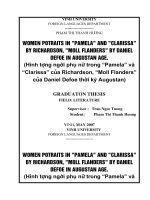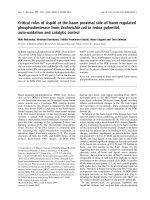Portrait in Watercolour pot
Bạn đang xem bản rút gọn của tài liệu. Xem và tải ngay bản đầy đủ của tài liệu tại đây (187.39 KB, 17 trang )
Portrait in Watercolour
"Nelson Mandela Portrait in Watercolour"
Cadmium
Yellow
Cerulean
Blue
Burnt
Umber
Blue
Black
Quinacridone
Gold
Geranium
Lake
Bluish
Payne's
Grey
Additional colour (not shown) - Prussian blue
Equipment
1. PAPER - Stretched sheet of
watercolour paper (mine is
Saunders Waterford 300g Rough
Surface).
2. PAINT - Winsor & Newton
Artists' Watercolour tubes -
Cadmium Yellow, Cerulean Blue,
Burnt Umber, Blue Black,
Quinacridone Gold. Lukas Artist's
Watercolour tubes - Geranium
"Most painting in the
European tradition was
painting the mask. Modern art
rejected all that. Our subject
matter was the person behind
the mask."
- Robert Motherwell
Lake Bluish (a vivid, clean bright
pink), Payne's Grey.
3. BRUSHES - Cotman 00; one
inch, half inch, quarter inch flat.
4. MASKING FLUID
5. ERASER
6. PENCIL - Very sharp B
Working from a photo:
Here I am working from photo
reference - a photo that appears on
the cover of Nelson Mandela's
biography, "Long Walk to
Freedom". The photo is by A.
Tannenbaum.
When working from 2-
dimensional reference material, I
often find it very helpful to adjust
the picture on my computer. I
scan the image, then accentuate
the CONTRAST. This helps me to
see the tonal areas as simple
shapes.
For example, see here how the
right side of the face is just one
continuous black shape. There is
no indication of where "face" ends
and "neck" begins, nor where
"hair" ends and "forehead" begins.
TIP: When looking for suitable
reference material for portraits,
look for photos that have as much
contrast as possible. Well-lit
studio portraits are often too
uniformly lit for watercolour
painting purposes.
Drawing:
My pencil lines are very faint
here, but they indicate more than
simply the outlines of familiar,
nameable objects (such as nose,
eye, lips). My pencil lines indicate
shapes that have no name. If I
were to try to name them, they
would be called something like:
"shape under the left eye where
the light is falling".
It is really vitally important to
"see" all these such shapes before
beginning to paint. In watercolour,
you haven't got time to mess
about once the paint starts being
applied. So you want as many
guide lines as possible to tell you
where one shape ends and another
begins. Sometimes these changes
in shape are soft-edged,
sometimes they are sharp-edged.
Either way, they should be drawn
in.
Please refer to Painting
Demonstration No. 1 for more
details about placement on the
page and my "paint-by-numbers"
drawing technique.
TIP: It's always a good idea to
leave extra space in front of where
your subject is looking, in the
direction the subject is looking -
thus, here I have left more space
on the left.
Painting the darks:
Unlike "traditional" watercolour
technique, where the artist works
from the lightest area to the
darkest area, I do something
different.
My first layer of paint is pure
Ultramarine Blue. Using a 1/2
inch flat brush, I apply this colour
to all tonal areas which are
medium to dark. This blue layer is
based solely on shape and tone
and includes areas like the eyes. I
soften edges where necessary with
a damp brush.
This first blue layer can look
alarmingly strong to begin with,
but by the end of the painting, it is
barely visible.
TIP: Look carefully at the eyes.
There is almost always a bright
sparkle of pure white within the
eye. It's very important to keep
this sparkle WHITE. You can
either use masking fluid (see
demo 2) or very carefully paint
around the sparkle. Also look for
a sparkle in the area of the eye's
tear duct.
What colour is skin?
In normal working circumstances,
I would complete the layer of
blue, then leave it to dry. This
painting was an exception because
it was painted for a workshop
class and I demonstrated the next
layer (using colour) before
completing the blue layer.
Once the Ultramarine Blue layer
is completely dry, I can begin to
add colour. My basic skin colour
is a mixture of PINK, any
YELLOW (I have used Cadmium)
and any BLUE (I have used
Ultramarine). This is the case for
a black and a white-complexioned
skin - the tone (or strength of the
mix) is the only difference.
In this 3-colour mix, the pink is
vitally important. If you cannot
get Lukas "Geranium Lake
Bluish", try colours such as
Alizarin Crimson, Magenta or
Permanent Rose. You can see how
I have fiddled with the basic skin
tone at the bottom of the painting.
I use Burnt Umber, mixed with a
touch of blue, on the two sides of
the forehead. While this paint is
still wet, I add my basic skin
colour in varying degrees of tone
and mix. (The basic skin colour is
warmer when there is more pink
added, cooler when there is more
blue added)
Great excitement about this
portrait - the flashes of
Quinacridone Gold above the eyes
and judiciously-used Prussian
Blue above and below the left eye
and beneath the nose. Do take
care with Prussian Blue - it is very
strong.
TIP: To achieve luminous, life-
like skin - avoid using red! Red
mixes to create murky, muddy
colours.
Layers and layers like an onion:
In this detailed view, you can still
see the faint Ultramarine Blue
base. Can you see here how the
paint forms skins like an onion,
one on top of another? This is the
beauty of transparent watercolour.
It is ideal for representing skin.
Skin is also made up of layers
upon layers.
Notice the white "sparkles" in the
eyes. The actual "whites" of the
eyes are seldom white. They are
usually a very pale blue.
Also look closely at the different
quality of edges - some hard,
some soft.
All of this painting is done using a
1/2 inch flat brush. For more
detailed areas, like the eyes and
the creases in the cheeks, the
brush is turned on its side to use
the edge of the brush. Using a big
brush helps to keep my painting
loose.
Note that some areas (like part of
the bottom lip) have not been
painted at all.
The eyes - Windows to the soul:
I allow the paint to dry completely
before proceeding.
At this stage, I usually need to
orientate myself with regard to
TONE. So I will work on the
eyes, for it is in the eyes that my
very darkest darks and my lightest
lights are to be found.
For detailed areas like the eyes, I
use a small brush and paint very
carefully. We tend to think of the
iris of the eye as brown, green or
blue, but when painting the eye,
light effects the way colour is
seen. Sometimes the pupil of the
eye cannot be distinguished at all,
as was the case here.
Here, the colour and tone of the
iris, the pupil and the lids of the
eye are one continuous shape and
are extremely dark. I have used a
mix of Payne's Grey and Burnt
Umber with very little water.
Once the eyes are done, I can now
see that I need to add more dark
tones in other areas of the
painting. It helps to squint at the
painting to see whether more
darks are needed.
Here I have added more pigment
(the same basic 3 colours as used
before). Payne's Grey in varying
strengths has been added to the
hair and suit.
What a happy accident - the
delicious brush stroke on the suit's
right side. That is going to stay
just as it is, it's too beautiful to
alter. In fact, I like the idea of the
face being quite detailed and the
suit and tie being more painterly.
TIP: Be alert to happy accidents!
It is often these drips, runs and
spillages that can make an
ordinary painting extraordinary!
More dark:
Once again, I leave the painting to
dry. Then I add more darks. In
areas like the mouth (see how
black the corners of the mouth
are?) the ears, the neck. I add
some Burnt Umber into my basic
3-colour mix, to make the right
side of the face even darker. I also
neaten up the hair a bit.
I add Cerulean Blue to the shirt. In
this painting, I have also slightly
darkened some of the white areas
- like the top of the lip and the
area above the left eye.
TIP: Cerulean Blue, very diluted
with water, is an ideal colour for
the "whites" of the eyes.
Does the painting need a
background?
As you will see from my wildlife
paintings, I believe background is
only necessary if it serves a useful
purpose. My painting is about
Nelson Mandela, it is not about a
background. The simpler the
better. Don't be tempted to add a
background just because you are
afraid of white space. Use white
space to your advantage - to
concentrate your viewer's
attention on your subject matter.
Here, the shape of the head and
shoulders is great - why mess with
a good thing?
Contemplating the universe:
This is when I make myself a cup
of coffee and look at my painting
from a distance. Maybe the
painting is finished, maybe not.
Perhaps I will leave it displayed
somewhere, while I am busy
doing something else. Sometimes,
if I'm not sure about a painting, I
turn it toward the wall and won't
look at it for a week.
This painting just needed to be
trimmed, signed, then given to
Madiba as a gift.
TIP: When painting teeth, avoid
painting the spaces between the
teeth. Rather, paint the gums (if
they show) and the shapes beneath
or above the rows of teeth.
TIP: When painting hair, try to
simplify as much as possible.
Look for basic shapes within the
hair. If you want to, you can paint
individual hairs in some areas, but
LOOK carefully first - which way
does the hair fall, how does light
effect its shape, what colour is it?
As with the rest of the face, see
shape.









